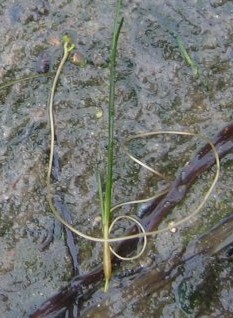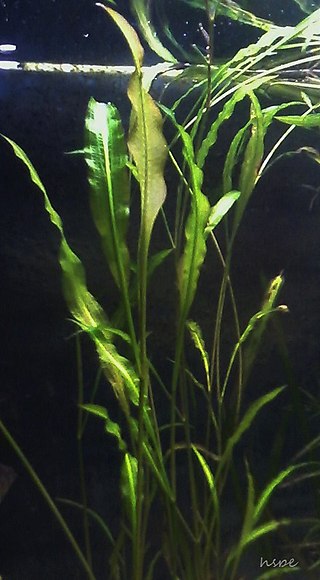Antitropicaldistribution is a type of disjunct distribution where a species or clade exists at comparable latitudes across the equator but not in the tropics. For example, a species may be found north of the Tropic of Cancer and south of the Tropic of Capricorn, but not in between. With increasing time since dispersal, the disjunct populations may be the same variety, species, or clade. How the life forms distribute themselves to the opposite hemisphere when they can't normally survive in the middle depends on the species; plants may have their seed spread through wind, animal, or other methods and then germinate upon reaching the appropriate climate, while sea life may be able to travel through the tropical regions in a larval state or by going through deep ocean currents with much colder temperatures than on the surface. For the American amphitropical distribution, dispersal has been generally agreed to be more likely than vicariance from a previous distribution including the tropics in North and South America.

Sparganium (bur-reed) is a genus of flowering plants, described as a genus by Linnaeus in 1753. It is widespread in wet areas in temperate regions of both the Northern and Southern Hemispheres. The plants are perennial marsh plants that can grow to 3.5 m, with epicene flowers.

Najas, the water-nymphs or naiads, is a genus of aquatic plants. It is cosmopolitan in distribution, first described for modern science by Linnaeus in 1753. Until 1997, it was rarely placed in the Hydrocharitaceae, and was often taken as constituting the family Najadaceae.

Ruppia, also known as the widgeonweeds, ditch grasses or widgeon grass, is the only extant genus in the family Ruppiaceae, with eight known species. These are aquatic plants widespread over much of the world. The genus name honours Heinrich Bernhard Rupp, a German botanist (1688-1719). They are widespread outside of frigid zones and the tropics.

Nobuyuki Tanaka is an economic botanist at the Tokyo Metropolitan University, the Makino Botanical Garden in Kōchi Prefecture, Japan.

Lemna trisulca L. is a species of aquatic plants in the arum family Araceae. It has a subcosmopolitan distribution. Unlike other duckweeds, it has submerged rather than floating fronds, except when flowering or fruiting. Also unlike other duckweeds, a large number of fronds remain attached to each other at a time.

Ruppia cirrhosa is a species of aquatic plant known by the common names spiral ditchgrass and spiral tasselweed. It is native to the Americas and Europe, where it grows in freshwater bodies, such as lakes. It is a thread-thin, grasslike perennial herb which grows from a rhizome anchored in the wet substrate. It produces a long, narrow inflorescence tipped with two tiny flowers. As the fruit develops the peduncle of the inflorescence curls into a neat spiral.

Ruppia maritima is an aquatic plant species commonly known as beaked tasselweed, beaked ditchgrass, ditch grass, tassel pondweed and widgeon grass. Despite its scientific name, it is not a marine plant; is perhaps best described as a salt-tolerant freshwater species. The generic name Ruppia was dedicated by Linnaeus to the German botanist Heinrich Bernhard Ruppius (1689–1719) and the specific name (maritima) translates to "of the sea".
Potamogeton maackianus is an aquatic plant species in the genus Potamogeton. It is found in slow moving fresh water.

Potamogeton octandrus is an aquatic plant species in the genus Potamogeton. It is found in slow-moving fresh water. The specific epithet means 'eight-stamened'.

Potamogeton wrightii, is an aquatic plant species in the genus Potamogeton. It is found in slow-moving fresh water.

Ruppia tuberosa is a submerged herb in the genus Ruppia found in shallow hypersaline waters in Australia.

Nechamandra is a monotypic genus of an aquatic plant family Hydrocharitaceae. The sole species is Nechamandra alternifolia. It is found in slow moving fresh water.
Cryptocoryne cruddasiana is a plant species belonging to the Araceae genus Cryptocoryne.
Chloroplast capture is an evolutionary process through which inter-species hybridization and subsequent backcrosses yield a plant with new genetic combination of nuclear and chloroplast genomes. For instance, 1) species A's pollen hybridizes (backcross) to species B's ovule, yielding the 1st hybrid (F1) with chloroplast genome b and nuclear genome A (50%) and B (50%); 2) species A's pollen again hybridizes (backcross) to F1's ovule, yielding the 2nd hybrid (F2) with chloroplast genome b and nuclear genome A (75%) and B (25%); 3) species A's pollen again hybridizes (backcross) to F2's ovule, yielding the 3rd hybrid (F3) with chloroplast genome b and nuclear genome A (87.5%) and B (12.5%); 4) after further backcross generations, a plant is obtained with the new genetic combination.

Caldesia parnassifolia, is an aquatic species in the Alismataceae. It is found in slow-moving fresh water.
Norio Tanaka is an aquatic botanist at Tsukuba Botanical Garden, National Science Museum, Tokyo, Japan.

Najas tenuis is a species of aquatic plant found in freshwater habitats, especially still or slow-moving waters, like ponds and rice fields.
Ruppia bicarpa is an aquatic plant species in the genus Ruppia of Ruppiaceae. It is found in shallow waters.
Ruppia spiralis is an aquatic plant species in the genus Ruppia of the family Ruppiaceae. This name was synonymized under R. cirrhosa, but it has been resurrected for the species previously referred to as R. cirrhosa.












